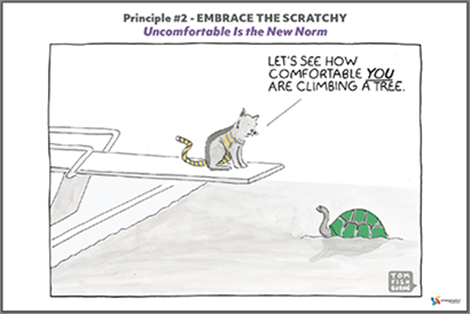
The New Year always seems flooded with messages of a “New Year, New You.” At Emergenetics, we think you are perfect as you are and that you should celebrate the things that make you unique.
That was the focus of my blog post on the first principle of Work That Works. The post highlighted the fact that Leadership Is an Inside Job, and you should become comfortable with who you are as a leader. I encourage you to read (or re-read) that as we dive into the New Year and the next principle of my book.
Now that you are comfortable with you, I am going to ask you to be okay with stepping outside of your comfort zone, something I call “feeling scratchy.” I dive deeply into the benefits of discomfort in Work That Works.
I’m sure you have heard, read or seen many inspirational quotes about the importance of bucking the status quo. I’d like to share some of the business reasons why you should consider taking those quotes to heart.
There are no shortage of companies that failed to evolve their business practices, leading to their demise. Some of the classic case studies include Blockbuster, Sears and Kodak.
In fact, feeling uncomfortable is linked to good business practices like innovation and creativity, transparency into problems that may exist in your company and identifying future challenges so you can respond proactively.
Now, try applying this logic to your role within your company. If you do not feel any discomfort in your job, you are likely not learning new skills that will help you, your employees and your organization.
As an existing or aspiring leader, you have a responsibility to set an example for other employees and encourage them to take risks that will propel the company forward. A great place to start is by modeling behaviors and embracing the scratchy yourself.
So, how do you start?
1. Understand yourself.
It all starts with self-awareness. Understand how you prefer to think and behave, acknowledge your talents and consider some of your least-preferred attributes (the Emergenetics Profile can help with this). Then, reflect on areas where you can flex to improve outcomes.
2. Start small by picking one thing that will make you feel scratchy each week.
While getting out of your comfort zone is important, it can cause undue stress if you leap too far. There was a study in 1908 by Robert Yerkes and John Dodson that spoke about optimal anxiety. The basic concept is that, while trying new things will make you feel uncomfortable, identify small- to medium-sized changes you can make, not ones so large that they prevent you from trying a new thing ever again!
3. Be open about the risks you are taking.
While you may be trying new things, your team members may not realize you are embracing a new skill unless you are open about it. When they learn that you are stepping outside of your comfort zone, they will likely feel more inclined to embrace the scratchy themselves.
4. Ask for feedback.
For most of us, when we try to learn a new skill, we do want to get good at flexing those muscles. Ask your employees and team members how you’re doing as you work towards your stated goals.
How does this work in practice?
To find a place to start, think about whether you have a company culture or leadership style that supports all thinking and behavioral preferences.
As an example, perhaps your Emergenetics Profile demonstrates that you have a strong Social preference and have gregarious behavioral preferences (as pictured to the left).
You have noticed that, while your meetings are full of laughter and opportunities to catch up, they often end 10 minutes late. You have also noticed that some of your attendees, particularly those with Structural or Analytical preferences (example pictured below), keep glancing at their watches during the last few minutes of the meeting.
One way to consider the preferences of others would be to set a goal that focuses on time management. Specifically, your goal could be to make sure that all of your meetings end on time. Making your employees happy will also serve your Social thinking needs!
Tell your team members that this is a new focus of yours and start embracing the scratchiness that may come from limiting some of the side conversations in your meeting. Or, consider finding the people you want to catch up with after your meeting and chat then.
Ask for feedback on how you are doing during the week, particularly from those with Structural and Analytical preferences. Please know that leaning into others’ preferences does not mean totally effacing your own. By considering others’ needs, you can find a better balance between yours’ and others’ preferences and foster a work environment that supports everyone.
When you begin to model the way, be open about the changes you are making and be receptive to feedback throughout the process. Not only will you learn more but you will also foster an environment where others feel encouraged to try new things. That is when amazing things begin to happen for you, your employees and your bottom line!
For the month of January, rather than building a “New You,” try to Embrace the Scratchy and start to experience the positive changes that come from getting comfortable with discomfort!
In the meantime, I will be preparing my next blog post on the third principle of Work That Works: Using the Language of Grace. Words Are Powerful.
For more ideas on how to Embrace the Scratchy and implement these practices, get your copy of Work That Works!
 Print This Post
Print This Post


